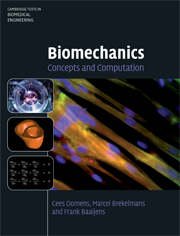Book contents
- Frontmatter
- Contents
- About the cover
- Preface
- 1 Vector calculus
- 2 The concepts of force and moment
- 3 Static equilibrium
- 4 The mechanical behaviour of fibres
- 5 Fibres: time-dependent behaviour
- 6 Analysis of a one-dimensional continuous elastic medium
- 7 Biological materials and continuum mechanics
- 8 Stress in three-dimensional continuous media
- 9 Motion: the time as an extra dimension
- 10 Deformation and rotation, deformation rate and spin
- 11 Local balance of mass, momentum and energy
- 12 Constitutive modelling of solids and fluids
- 13 Solution strategies for solid and fluid mechanics problems
- 14 Solution of the one-dimensional diffusion equation by means of the Finite Element Method
- 15 Solution of the one-dimensional convection-diffusion equation by means of the Finite Element Method
- 16 Solution of the three-dimensional convection-diffusion equation by means of the Finite Element Method
- 17 Shape functions and numerical integration
- 18 Infinitesimal strain elasticity problems
- References
- Index
15 - Solution of the one-dimensional convection-diffusion equation by means of the Finite Element Method
Published online by Cambridge University Press: 05 June 2012
- Frontmatter
- Contents
- About the cover
- Preface
- 1 Vector calculus
- 2 The concepts of force and moment
- 3 Static equilibrium
- 4 The mechanical behaviour of fibres
- 5 Fibres: time-dependent behaviour
- 6 Analysis of a one-dimensional continuous elastic medium
- 7 Biological materials and continuum mechanics
- 8 Stress in three-dimensional continuous media
- 9 Motion: the time as an extra dimension
- 10 Deformation and rotation, deformation rate and spin
- 11 Local balance of mass, momentum and energy
- 12 Constitutive modelling of solids and fluids
- 13 Solution strategies for solid and fluid mechanics problems
- 14 Solution of the one-dimensional diffusion equation by means of the Finite Element Method
- 15 Solution of the one-dimensional convection-diffusion equation by means of the Finite Element Method
- 16 Solution of the three-dimensional convection-diffusion equation by means of the Finite Element Method
- 17 Shape functions and numerical integration
- 18 Infinitesimal strain elasticity problems
- References
- Index
Summary
Introduction
This chapter extends the formulation of the previous chapter for the one-dimensional diffusion equation to the time-dependent convection-diffusion equation. Although a good functioning of the human body relies on maintaining a homeostasis or equilibrium in the physiological state of the tissues and organs, it is a dynamic equilibrium. This means that all processes have to respond to changing inputs, which are caused by changes of the environment. The diffusion processes taking place in the body are not constant, but instationary, so time has to be included as an independent variable in the diffusion equation. Thus, the instationary diffusion equation becomes a partial differential equation.
Convection is the process whereby heat or particles are transported by air or fluid moving from one point to another point. Diffusion could be seen as a process of transport through immobilized fluid or air. When the fluid itself moves, particles in that fluid are dragged along. This is called convection and also plays a major role in biomechanics. An example is the loss of heat because moving air is passing the body. The air next to the body is heated by conduction, moves away and carries off the heat just taken from the body. Another example is a drug that is released at some spot in the circulation and is transported away from that spot by means of the blood flow. In larger blood vessels the prime mechanism of transportation is convection.
- Type
- Chapter
- Information
- BiomechanicsConcepts and Computation, pp. 264 - 276Publisher: Cambridge University PressPrint publication year: 2009



